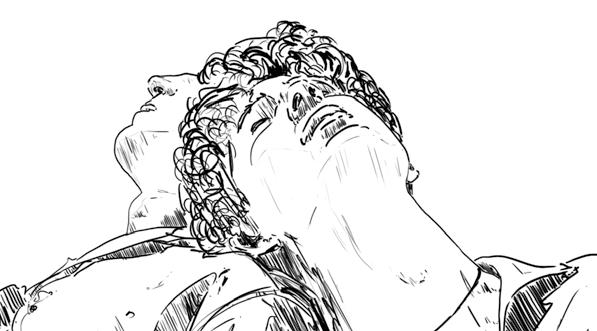
6 minute read
A Romantic Revolution
THE BREAKING OF BOUNDARIES IN 19TH CENTURY ENGLAND: LITERATURE, HISTORY AND RELIGION.
When Literature students learn of the Romantic period, it is often marked with images of Wordsworth and Blake alongside descriptions of a rapidly developing society brimful of revolutions, factories and social discontent. Such negative connotations of the early 19th Century adds an ironic element to the title of the ‘Romantic Era’ in which figureheads such as Constable, Shelley, Keats and Byron pushed the budding boundaries of suffering and exploitation placed upon the lower classes. Literature was not the only medium being used to push, and create. The historical nature of Victorian Society also laid the foundations for questioning traditional beliefs and standards. Yet the still very austere society continued to shun and often ridicule many female figures and scientists for their attempts at progression. Let me take you on a whistle-stop tour of the defining
Advertisement
moments of the 19th Century, those that both imposed boundaries and those that began to break them. HISTORY
The turn of the 19th Century marked the consequences of the groundbreaking American Revolution of 1775. For the first time, the looming presence of the oppressive British Empire was being threatened by revolutionaries dreaming of a better tomorrow, fighting red coats with international assistance from France; a country which would later overthrow its’ own revolution against its monarchy.
With the cultivation of revolutions that altered the social and political scene internationally, the same was expected of England and the current monarchy was preparing for a rebellion from the public against the State. A revolution did occur; however, it was not in the form of riots or rampages but with the growth of factories, machines and steam engines. The Industrial Revolution of the 18th and 19th centuries was one to create boundaries not to dismantle them. With the developments of urban labour there were advancements in transport, communications and production, the cost for such developments were, however, too high as the revolution encouraged the exploitation of the lower classes through extensive hours in dangerous conditions with meagre wages that barely covered basic costs. Children were being taken out of school and forced under machines, where they often risked their lives so as to not be thrown out onto the streets. RELIGION
The advancements of machinery and science also encouraged the questioning of the boundaries placed on society by the overriding authority and suffocating presence of the Church. Alternative approaches to the answering of existential questions on the nature of our universe and purpose began to undermine faith alone in an omnipotent and fearful presence. Darwin’s ‘On the Origin of Species’, published in 1859, challenged the presumption that all things within our world were created by God alone, instead offering a scientific style of thinking in reaching an answer to the nature of the world around us. The controversy sparked through Darwin’s work is still reflected within our modern day world, with the book being banned in several American States until the late 1900’s. Darwin certainly did not stand in isolation with his opposing scientific view as Biologist Thomas Henry Huxley coined the word ‘Agnosticism’, advocating for the questioning of the Church’s authority and promoting the integration of science on the social agenda.
LITERATURE
Poet William Blake summarizes the tone of the 19th Century almost perfectly: ‘In every cry and every man/In every infant’s cry of fear’. In his own way, Blake pushes the boundaries of the Romantic Movement, choosing to project the reality of suffering and discontent within his poetry and art instead of disillusioning himself with the metaphors of daffodils and nightingales that his contemporaries were creating. When studying the literary movement of the 19th Century we look to a group of writers now known as ‘The Romantic Poets’ who valued emotion and the appreciation of nature to reach an understanding of the world around us, pushing the boundaries that were being imposed by the growing scientific and industrial revolution which stifled the authentic and rural way of living. One of the most famous of these poets, Lord Byron, epitomises the movement in his refusal to conform to rules. Indeed, Byron famously brought a bear as a companion with him to Cambridge upon being told that there was a ‘No Dog’ regulation in the dormitories (there was however, no rules against bears). Despite such initial progressive connotations that surround the group of Romantics, they imposed boundaries of their own by dismissing, the now widely respected John Keats as a ‘common cockney’. Keats’ poetry remained ignored for his whole life, a mere 25 years, simply because he was not of the same social status as his contemporaries, living a draining life within the East-End London slums. It is in the years after his death that Keats pushed the boundaries and labels imposed upon him as he is now considered to be the greatest of the English poets and, had he only lived longer, a rival of William Shakespeare.

The Romantic literary movement also contains prominent female writers who pushed the boundaries enforced upon them by society, religion and politics. Writing in the time where proto-feminists, such as Mary Wollstonecraft were ridiculing the limited nature of female education, Jane Austen also reflects her feminist beliefs within elements of her six novels regarding the social progression of women through equal access to education. Austen also looks far ahead of her time and tackles the question of social status within ‘Pride and Prejudice’, focusing on the judgemental and critical approach of the upper classes towards others through her famous descriptions of ballroom dances. The invention of ‘ScienceFiction’ is credited to Mary Shelley, her novel ‘Frankenstein’ was an instant hit and also a social comment on the dangers of Scientific progression. Not only was Shelley pushing the boundaries of the social assumptions of ‘weakness’ and ‘delicacy’ towards the female sex, but also comments upon the prominent social questions posed by the 19th Century, debating whether such progression breaks barriers or creates them.
The revolutions, the scientific advancements, the rejection of ultimate Church authority and the viewing of authoritative female figures in the public arena all point to a century that breaks the multitude of boundaries that was previously imposed upon the lives of many. However, the viewing the 19th Century as an ‘era of progression’ remains a difficult task. The monstrous growth of the Industrial Revolution destroyed the rural country of England as well as the lives of the lower and working classes. The scientific advancements, developed alongside fundamentalist criticisms, created a division between faith and reason that still remains relevant today. Despite the rise of female figures that began to defy the social boundaries placed upon them, women would not get the vote until some hundred years later in 1918 or receive pay equal to their male counterparts; an issue still not yet resolved in 2019. Yet the 19th Century remains fascinating for this very reason: never since has there been an era so defined by such extreme growth but also by such extreme rigidity.
G Pratt, Lower Sixth






